Paris Peace Conference, 1919 - Picture
More about World War 1
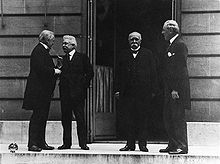
|
|
Paris Peace Conference, 1919

Picture - "The Big Four" during the Paris Peace Conference (from left to right, David Lloyd George, Vittorio Orlando, Georges Clemenceau, Woodrow Wilson)
The Paris Peace Conference was the meeting of the Allied victors following the end of World War I to set the peace terms for Germany and other defeated nations, and to deal with the empires of the defeated powers following the Armistice of 1918. It took place in Paris in 1919 and involved diplomats from more than 29 countries. They met, discussed and came up with a series of treaties ("Paris Peace Treaties") that reshaped the map of Europe and the world, and imposed guilt and stiff financial penalties on Germany. At its center were the leaders of the three "Great Powers": President Woodrow Wilson of the USA, and Prime Ministers David Lloyd George of Great Britain and Georges Clemenceau of France, with Prime Minister Vittorio Orlando of Italy being the next most powerful figure to create the "Big Four". Germany and newly communist Russia were not invited to attend, but numerous other nations did send delegations, each with a different agenda. Kings, prime ministers and foreign ministers with their crowds of advisers rubbed shoulders with journalists and lobbyists for a hundred causes, ranging from independence for the countries of the South Caucasus to women's rights. For six months Paris was effectively the center of a world government, as the peacemakers wound up bankrupt empires and created new countries. The most important results included a punitive peace treaty that declared Germany guilty, weakened its military, and required it to pay all the costs of the war to the winners. This was known as the War Guilt Clause that was included in the final Treaty of Versailles. The Austro-Hungarian Empire had ceased to exist as its disparate peoples created new states. The Conference also created the League of Nations.
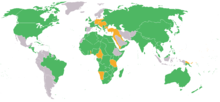
Picture - Map of the world with the participants in World War I. The Allies are depicted in green, the Central Powers in orange, and neutral countries in grey.
Historians debate whether or not the terms imposed on Germany helped the rise of Nazi Germany and were thus a cause of World War II, and whether the terms were the best that could be expected, given the mood of the victors.
Overview
The conference opened on 18 January 1919. The opening date was deliberately chosen by the French so as to ensure the conference would commence on the anniversary of the Unification of Germany which had been proclaimed at Versailles 48 years earlier. The conference came to an end on 21 January 1920 with the inaugural General Assembly of the League of Nations.
The following treaties were prepared at the Paris Peace Conference (with, in parentheses, the affected countries):
the Treaty of Versailles, 1919, 28 June 1919, (the German Empire in Weimar Republic form)
the Treaty of Saint-Germain, 10 September 1919, (Austria)
the Treaty of Neuilly, 27 November 1919, (Bulgaria)
the Treaty of Trianon, 4 June 1920, (Hungary)
the Treaty of Sx¨vres, 10 August 1920; subsequently revised by the Treaty of Lausanne, 24 June 1923, (Ottoman Empire).
The so-called "Paris Peace Treaties", together with the accords of the Washington Naval Conference of 1921-1922, laid the foundations for the so-called Versailles-Washington system of international relations. The remaking of the world map at these conferences gave birth to a number of critical conflict-prone international contradictions, which would become one of the causes of World War II.
The decision to create the League of Nations and the approval of its charter both took place during the conference.
The "Big Four" - Georges Clemenceau, Prime Minister of France; David Lloyd George, Prime Minister of Great Britain; Woodrow Wilson, President of the United States; and Vittorio Emanuele Orlando, Prime Minister of Italy - were the dominant diplomatic figures at the conference. The conclusions of their talks were imposed on the defeated countries.
British approach
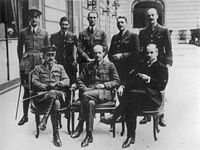
Picture - The British Air Section at the Conference
Maintenance of the British Empire's unity, holdings and interests were an overarching concern for the British delegates to the conference, but it entered the conference with the more specific goals of:
Ensuring the security of France
Removing the threat of the German High Seas Fleet
Settling territorial contentions
Supporting the Wilsonian League of Nations
with that order of priority.
The Racial Equality Proposal put forth by the Japanese did not directly conflict with any of these core British interests. However, as the conference progressed the full implications of the Racial Equality Proposal, regarding immigration to the British Dominions (with Australia taking particular exception), would become a major point of contention within the delegation.
Ultimately, Britain did not see the Racial Equality proposal as being one of the fundamental aims of the conference. The delegation was therefore willing to sacrifice this proposal in order to placate the Australian delegation and thus help satisfy its overarching aim of preserving the unity of the British Empire.
Although Britain reluctantly consented to the attendance of separate Dominion delegations, the British did manage to rebuff attempts by the envoys of the newly proclaimed Irish Republic to put its case to the Conference for self-determination, diplomatic recognition and membership of the proposed League of Nations. The Irish envoys' final "Demand for Recognition" in a letter to Clemenceau, the Chairman, was not replied to. Britain had planned to legislate for two Irish Home Rule states (without Dominion status), and did so in 1920. In 1919 Irish nationalists were unpopular with the Allies because of the Conscription Crisis of 1918.
David Lloyd George the Prime Minister claimed that he did "not do badly" at the peace conference, "considering I was seated between Jesus Christ and Napoleon." This was a reference to the very idealistic views of Woodrow Wilson (US President) and Georges Clemenceau (France), who was determined to see Germany punished.
Canada
The British Dominion governments were not originally granted separate invitations to the conference, but rather were expected to send representatives as part of the British Empire delegation.
Convinced that Canada had become a nation on the battlefields of Europe, her Prime Minister Sir Robert Borden demanded that it have a separate seat at the conference. This was initially opposed not only by Britain but also by the United States, who perceived such a delegation as an extra British vote. Borden responded by pointing out that since Canada had lost a far larger proportion of her men compared the U.S. in the war (although not more in absolute numbers), Canada at least had the right to the representation of a "minor" power. British Prime Minister David Lloyd George eventually relented, and convinced the reluctant Americans to accept the presence of separate Canadian, Indian, Australian, Newfoundland, New Zealand and South African delegations.
Despite this, Borden boycotted the opening ceremony, protesting at the precedence given to the prime minister of the much smaller Newfoundland over him.
Australia
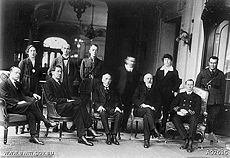
Picture - The Australian delegation. The center is Prime Minister of Australia Billy Hughes
The Australian delegation, led by Prime Minister Billy Hughes, wanted war reparations, annexation of German New Guinea and rejection of the Japanese racial equality proposal. Hughes obtained a class C mandate for New Guinea.
President Wilson was especially offended by Australian demands and asked Hughes if Australia really wanted to flout world opinion by profiting from Germany's defeat and extending its sovereignty as far north as the equator; Hughes famously replied: "That's about the size of it, Mr. President".
Chinese approach
The Chinese delegation was led by Lou Tseng-Tsiang, accompanied by Wellington Koo and Cao Rulin.
Before the Western powers, Koo demanded that Japan return Shandong to China. He further called for an end to imperialist institutions such as extraterritoriality, legation guards, and foreign lease holds. Despite American support and the ostensible spirit of self-determination, the Western powers refused his claims. Thus the Chinese delegation at the Paris Peace Conference was the only one not to sign the Treaty of Versailles at the signing ceremony.
French approach
The French Prime Minister Georges Clemenceau's chief goal was to weaken Germany militarily, strategically and economically. Having personally witnessed two German attacks on French soil in the last forty years, he was adamant that Germany should not be permitted to attack France again. In particular, Clemenceau sought an American and British guarantee of French security in the event of another German attack. Clemenceau also expressed skepticism and frustration with Wilson's Fourteen Points: "Mr. Wilson bores me with his fourteen points", complained Clemenceau. "Why, God Almighty has only ten!" Wilson did sign a mutual defense treaty with France, but back in Washington the Senate refused to ratify it.
Another alternative French policy was to seek a rapprochement with Germany. In May 1919 the diplomat René Massigli was sent on several secret missions to Berlin. During his visits Massigli offered on behalf of his government to revise the territorial and economic clauses of the upcoming peace treaty. Massigli spoke of the desirability of “practical, verbal discussions” between French and German officials that would lead to a “collaboration franco-allemand”. Furthermore, Massagli told the Germans that the French thought of the "Anglo-Saxon powers", namely the United States and British Empire, to be the major threat to France in the post-war world. He argued that both France and Germany had a joint interest in opposing "Anglo-Saxon domination" of the world and warned that the "deepening of opposition" between the French and the Germans "would lead to the ruin of both countries, to the advantage of the Anglo-Saxon powers". The Germans rejected the French offers because they considered the French overtures to be a trap to trick them into accepting the Versailles treaty "as is" and because the German foreign minister, Count Ulrich von Brockdorff-Rantzau thought that the United States was more likely to reduce the severity of the peace terms than France. In the final event it proved to be Lloyd George who pushed for more favourable terms for Germany.
Italian approach
In 1882 Italy joined the German Empire and the Austro-Hungarian Empire forming the Triple Alliance. During World War I Italy aligned with the Allies, instead of joining its allies in the Triple alliance. In the Treaty of London, they had been offered the Trentino and the Tyrol as far as Brenner, Trieste and Istria, all the Dalmatian coast except Fiume, full ownership of Albanian Valona and a protectorate over Albania, Antalya in Turkey and a share of Turkish and German Empires in Africa.
Vittorio Orlando was sent as the Italian representative with the aim of gaining these and as much other territory as possible. The loss of 700,000 Italians and a budget deficit of 12,000,000,000 Lire during the war made the Italian government and people feel entitled to these territories. There was an especially strong opinion for control of Fiume, which they believed was rightly Italian due to the Italian population.
Nevertheless, by the end of the war the allies had made contradictory agreements with other nations, especially in Central Europe and the Middle-East. In the meetings of the "Big Four", in which Orlando's powers of diplomacy were inhibited by his lack of English the Great powers were only willing to offer Trentino to the Brenner, the Dalmatian port of Zara, the Island of Lagosta and a couple of small German colonies. All other territories were promised to other nations and the great powers were worried about Italy's imperial ambitions. As a result of this, Orlando left the conference in a rage.
Japanese approach
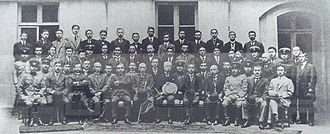
Picture - Japanese delegation at the Paris Peace Conference 1919.
The Japanese delegation was headed by Marquess Saionji Kinmochi (former Prime Minister), with Baron Makino Nobuaki (former Foreign Minister), Viscount Chinda Sutemi (ambassador in London), Matsui Keishiro (ambassador in Paris) and Ijuin Hikokichi (ja) (ambassador in Rome) and others making a total of 64. Neither Hara Takashi (Prime Minister) nor Yasuya Uchida (Foreign Minister) were prepared to travel so far from Japan so shortly after their election. The delegation focused on two demands: the inclusion of their racial equality proposal in the League's Covenant and Japanese territorial claims with respect to former German colonies, namely Shan Tung (including Kiaochow) and the Pacific islands north of the Equator (the Marshall Islands, Micronesia, the Mariana Islands, and the Carolines). Makino was de facto chief while Saionji's role was symbolic and limited by his ill health. The Japanese delegation became unhappy after receiving only one-half of the rights of Germany, and walked out of the conference.
Racial equality proposal
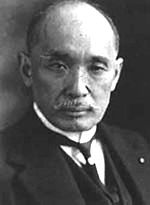
Picture - Baron Makino Nobuaki
Japan proposed including a "racial equality clause" in the Covenant of the League of Nations on February 13 as an amendment to Article 21:
The equality of nations being a basic principle of the League of Nations, the High Contracting Parties agree to accord as soon as possible to all alien nationals of states, members of the League, equal and just treatment in every respect making no distinction, either in law or in fact, on account of their race or nationality.
The equality of nations being a basic principle of the League of Nations, the High Contracting Parties agree to accord as soon as possible to all alien nationals of states, members of the League, equal and just treatment in every respect making no distinction, either in law or in fact, on account of their race or nationality.
Because he knew that Great Britain was critical to the decision, President Wilson, as Conference chairman, ruled that a unanimous vote was required. On April 11, 1919, the commission held a final session and the proposal received a majority of votes, but Great Britain and Australia opposed it. The Australians had lobbied the British to defend Australia's White Australia policy. The defeat of the proposal influenced Japan's turn from cooperation with West toward more nationalistic policies.
Territorial claims
The Japanese claim to Shan Tung was disputed by the Chinese. In 1914 at the outset of World War I Japan had seized the territory granted to Germany in 1897. They also seized the German islands in the Pacific north of the equator. In 1917, Japan had made secret agreements with Britain, France and Italy as regards their annexation of these territories. With Britain, there was a mutual agreement, Japan also agreeing to support British annexation of the Pacific islands south of the equator. Despite a generally pro-Chinese view on behalf of the American delegation, Article 156 of the Treaty of Versailles transferred German concessions in Kiachow, China to Japan rather than returning sovereign authority to China. The leader of the Chinese delegation, Lou Tseng-Tsiang, demanded that a reservation be inserted before he would sign the treaty. The reservation was denied, and the treaty was signed by all the delegations except that of China. Chinese outrage over this provision led to demonstrations known as the May Fourth Movement. The Pacific islands north of the equator became a class C mandate administered by Japan.
American approach
Prior to Wilson's arrival in Europe, no American President had ever visited Europe while in office. Wilson's Fourteen Points, of a year earlier, had helped win the hearts and minds of many as the war ended; these included Americans and Europeans generally, as well as Germany, its allies and the former subjects of the Ottoman Empire specifically. Wilson's diplomacy and his Fourteen Points had essentially established the conditions for the armistices that had brought an end to World War I. Wilson felt it was his duty and obligation to the people of the world to be a prominent figure at the peace negotiations. High hopes and expectations were placed on him to deliver what he had promised for the post-war era. In doing so, Wilson ultimately began to lead the foreign policy of the United States toward interventionism, a move strongly resisted in some domestic circles.
Once Wilson arrived, however, he found "rivalries, and conflicting claims previously submerged". He worked mostly trying to sway the direction that the French (Georges Clemenceau) and British (Lloyd George) delegations were taking towards Germany and its allies in Europe, as well as the former Ottoman lands in the Middle East. Wilson's attempts to gain acceptance of his Fourteen Points ultimately failed, after France and Britain refused to adopt some specific points and its core principles.
In Europe, several of his Fourteen Points conflicted with the other powers. The United States did not encourage nor believe that the responsibility for the war that Article 231 placed on Germany was fair or warranted. It would not be until 1921 that the United States finally signed separate peace treaties with Germany, Austria and Hungary.
In the Middle East, negotiations were complicated by competing aims, claims, and the new mandate system. The United States hoped to establish a more liberal and diplomatic world, as stated in the Fourteen Points, where democracy, sovereignty, liberty and self-determination would be respected. France and Britain, on the other hand, already controlled empires, wielded power over their subjects around the world, and still aspired to be dominant colonial powers.
In light of the previously secret Sykes-Picot Agreement, and following the adoption of the mandate system on the Arab province of the former Ottoman lands, the conference heard statements from competing Zionist and Arab claimants. President Woodrow Wilson then recommended an international commission of inquiry to ascertain the wishes of the local inhabitants. The Commission idea, first accepted by Great Britain and France, was later rejected. Eventually it became the purely American King-Crane Commission, which toured all Syria and Palestine during the summer of 1919, taking statements and sampling opinion. Its report, presented to President Wilson, was kept secret from the public until The New York Times broke the story in December 1922. A pro-Zionist joint resolution on Palestine was passed by Congress in September 1922.
France and Britain tried to appease the American President by consenting to the establishment of his League of Nations. However, because isolationist sentiment was strong and some of the articles in the League's charter conflicted with the United States Constitution, the United States never did ratify the Treaty of Versailles nor join the League of Nations, which President Wilson had helped create, to further peace through diplomacy rather than war and conditions which can breed it.
Under President Warren Harding the United States signed separate treaties with Germany, Austria, and Hungary in 1921.
Other issues
Ukraine
Ukraine had its best opportunity to win recognition and support from foreign powers at the Paris Peace Conference of 1919. At a meeting of the Big Five on 16 January, British prime minister David Lloyd George called Ukrainian leader Symon Petliura (1874-1926) an adventurer and dismissed Ukraine as an anti-Bolshevik stronghold. Sir Eyre Crowe, British undersecretary of state for foreign affairs, spoke against a union of East Galicia and Poland. The British cabinet never decided whether to support a united or dismembered Russia. The United States was sympathetic to a strong, united Russia as a counterpoise to Japan, but Britain feared a threat to India. Petliura appointed Count Tyshkevich his representative to the Vatican, and Pope Benedict XV recognized Ukrainian independence.
Israel
The Zionist Organization submitted their draft resolutions for consideration by the Peace Conference on February 3, 1919. This shortly followed the Conference's decision that the former Arab provinces of the Ottoman Empire should be separated from it and the newly conceived mandate-system applied to them.
The statement included five main points:
Recognition of the Jewish people's historic title to The Land of Israel and their right to reconstitute their National Home in Israel.
The boundaries of Israel were to be declared as set out in an attached Schedule.
The sovereign possession of Israel would be vested in the League of Nations and the Government entrusted to Great Britain as Mandatory of the League.
Other provisions to be inserted by the High Contracting Parties relating to the application of any general conditions attached to mandates, which are suitable to the case in Palestine.
The mandate shall be subject also to several noted special conditions, including the provision relating to the control of the Holy Places.
Minority Treaties
Czech Corridor
League of Nations mandate
German New Guinea (given as a mandate to Australia)
German Samoa (given as a mandate to New Zealand)
Commission of Responsibilities
Prince Lichnowsky
Further reading
Albrecht-Carrie, Rene. Italy at the Paris Peace Conference (1938) online edition
Ambrosius, Lloyd E. Woodrow Wilson and the American Diplomatic Tradition: The Treaty Fight in Perspective (1990) excerpt and text search
Andelman, David A. A Shattered Peace: Versailles 1919 and the Price We Pay Today (2007) popular history that stresses multiple long-term disasters caused by Treaty. excerpt and text search
Bailey; Thomas A. Wilson and the Peacemakers: Combining Woodrow Wilson and the Lost Peace and Woodrow Wilson and the Great Betrayal (1947) online edition
Birdsall, Paul. Versailles twenty years after (1941) well balanced older account
Boemeke, Manfred F., et al., eds. The Treaty of Versailles: A Reassessment after 75 Years (1998). major collection of important papers by scholars excerpt and text search
Clements, Kendrick, A. Woodrow Wilson: World Statesman (1999) excerpt and text search
Cooper, John Milton. Breaking the Heart of the World: Woodrow Wilson and the Fight for the League of Nations (2001) 454pp excerpt and text search
Dillon, Emile Joseph. The Inside Story of the Peace Conference, (1920)
Henig, Ruth. Versailles and After: 1919-1933 (2nd ed. 1995), 100 pages; brief introduction by scholar excerpt and text search
Keynes, John Maynard, The Economic Consequences of the Peace (1920) famous criticism by leading economist full text online
Knock, Thomas J. To End All Wars: Woodrow Wilson and the Quest for a New World Order (1995) excerpt and text search
Lederer, Ivo J. The Versailles Settlement-Was It Foredoomed to Failure? (1960) excerpts from scholars online edition
Lentin, Antony. Lloyd George and the Lost Peace: From Versailles to Hitler, 1919-1940 (2004)
Lentin, Antony. Guilt at Versailles: Lloyd George and the Pre-history of Appeasement (1985)
Macmillan, Margaret. Peacemakers: The Paris Conference of 1919 and Its Attempt to End War (2002), also published as Paris 1919: Six Months That Changed the World (2003); highly influential study excerpt and text search
Marks, Sally. The Illusion of Peace: International Relations in Europe 1918-1933 (2nd ed. 2003)
Mayer, Arno J., Politics and Diplomacy of Peacemaking: Containment and Counter-revolution at Versailles, 1918-1919 (1967), leftist
Newton, Douglas. British Policy and the Weimar Republic, 1918-1919 (1997). 484 pgs.
Schwabe, Klaus. Woodrow Wilson, Revolutionary Germany, and Peacemaking, 1918-1919: Missionary Diplomacy and the Realities of Power (1985) online edition
Sharp, Alan. The Versailles Settlement: Peacemaking after the First World War, 1919-1923 (2nd ed. 2008)
Sharp, Alan. "The Enforcement Of The Treaty Of Versailles, 1919-1923," Diplomacy and Statecraft 2005 16(3): 423-438
Naoko Shimazu (1998), Japan, Race and Equality, Routledge, ISBN 0-415-17207-1
Steiner, Zara. The Lights that Failed: European International History 1919-1933 (Oxford History of Modern Europe) (2007), major scholarly work excerpt and text search
Trachtenberg, Marc “Reparations at the Paris Peace Conference” pages 24-55 from The Journal of Modern History, Volume 51, Issue # 1, March 1979.
Walworth, Arthur. Wilson and His Peacemakers: American Diplomacy at the Paris Peace Conference, 1919 (1986) 618pp online edition
Watson, David Robin. Georges Clemenceau: A Political Biography (1976) 463 pgs. online edition
More aircraft.
Source: WikiPedia